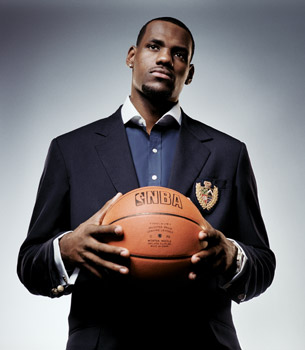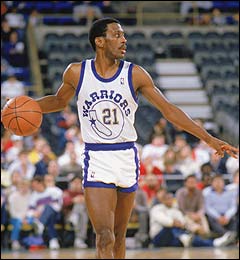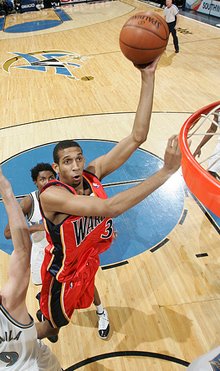
Missing Parts
Warriors made history last season by defeating the No. 1 seeded Mavericks and Mullin banked on bring back as many key pieces as possible to relive the magic for this season. All but one of the eight guys that played heavily down last year's stretch run and in the playoffs returned. A key piece that didn't return was Jason Richardson, but we seemed to be deep enough in the swingman department to overcome his lost production and spirit.
Although Mullin came up big with the Brandan Wright trade, he did not adequately address the key flaw in our roster which was exposed in the 2nd Round vs. the Utah Jazz - the lack of a physical presence in the paint that could battle against the Boozers, Duncans, and Amares of the West. Our roster wasn't even tough enough to handle the undersized athletic PF's either like Landry, Milsap, Thornton, and Maxiell. Al Harrington was the primary starter at PF with Pietrus, Barnes, Croshere and a few others taking turns trying to hold down the fort. Al's a good offensive player, but has proven throughout his career that he cannot defend the class of PF's that needed to be held in check in order for the Warriors to succeed. The almost nightly disparity in rebounds and points in the paint illustrate this point clearly. Teams would beat us consistantly in the half-court set by pounding it in the inside, grabbing offensive rebounds, and punishing the smaller Warrior frontline.
Croshere was supposed to give help at the PF position, but his chronic back problems didn't allow him to be utilized in the manner envisioned. When available, however, he proved that he was no longer able to play at as high a level that is necessary to have the impact on the boards and in the paint at both ends of the floor.
Another missing piece from the Warriors' roster was a backup to Baron that Nelson could trust to hand the game over to when Baron needed a rest. The ancient Troy Hudson was brought in for the vet minimum, but he soon fell by the wayside due to chronic hip pain that will likely force him to retire. Even when healthy, he never really was able to play with any degree of effectiveness.
Having no prototypical PF and no backup PG contributed mightily to this year's struggles in the end.
Undeveloped Bench
The Warriors have players that can contribute in areas that they struggle in (rebounding, blocks, post scoring, and backup guard-play. Problem is they were deemed not ready to contribute and saw very little playing time which derailed their development process and stunted their growth.
CJ Watson, a call-up dominating the D-League, would have been an adequate reliever for Baron a few minutes per game. He played like a vet his first game as a Warrior (vs. Trail Blazers). He was eventually signed on for the rest of the year, but despite the growing concerns for Baron's wear and tear, Nelson did not take the opportunity to play Watson and kill two birds with one stone - develop Watson into a better PG and get Baron some much needed rest. He has a 2.00 assist to turnover ratio (2nd best on team), a knack for stealing the ball, able to finish attacking the rim, and 3-point range. It would seem that all his skills would be good enough to allow him to get on the floor and be worthy of developing now and for the future.
Patrick O'Bryant, all 7' of him, does what the Warriors so desperately need - rebound, defense in the paint, and block shots. On top of that, he can pass, shoot from mid-range, and score in the post. Biedrins could have used a partner at the 5 spot other than the under-sized Harrington. O'Bryant would have been a great player to throw out there when the opposing team began to do lay-up drills in the middle of a game. He showed that he had turned a corner in his development beginning in training camp, into preseason, and early in the season. After his best game as a pro (vs. Clippers) in which he helped the team win with his defense and rebounding, the Warriors cut their 2nd round draft pick, Stephane Lasme, and signed D.J. Mbenga and mysteriously, the O'Bryant development plan was cast aside. Sure looks like we could have used him down the stretch. Had he continued to get the same minutes he was receiving early in the season, O'Bryant would have been able to make an impact and be one of our best bets to stop the opposing teams' scoring runs. Instead, we watch helplessly as early leads disappear, turn into double digit deficits, and finally end in losses that could have been prevented. The Warriors had an opportunity to develop another weapon but ignored the progress O'Bryant was making and decided to go with vets with only half the chance of succeeding.
Same goes with Brandon Wright. He's obviously a raw amazing talent (ranked #3 in his prep class behind Howard and Durant) that could have helped us tremendously with his disruptive length and agility. But for whatever reason, he stuck to the bench while the likes of Barnes, Croshere, Webber, Harrington, and Pietrus manned the middle with limited success. Undersized, under skilled, and ill-equip at times, Nellie would continue to go to the vets no matter how bad they were while Wright waited silently and patiently learning from the sidelines. Learn by doing is the best approach to getting better, but Wright was never really given a fair amount of opportunities to be able to develop in time for a stretch playoff run. Whenever he did manage to sneak into the game, his energy and length often sparked emotions, scoring runs, bothered shots, and made the opposing teams think twice about driving to the hoop. Sadly, a good game by Wright was never rewarded with additional playing time.
Marco Belinelli, the Italian sharpshooter that destroyed Team USA in the World Championships and wowed the Las Vegas Summerleague crowds with his shooting exhibitions, saw very little real-game experience as well. Belinelli was clearly the best 3 point shooter on the team in a team that loves to chuck it from deep. His defense needs work, but there were plenty of opportunities to stick him in the lineup for 3 to 5 min. stretches while surrounding him with the teams' best help defenders. The longer he sat, the less confident he became. He went from possible starting SG for the opening game, to garbage time scrub. I had high hopes that Belinelli would be able to help the team immediately, but boy was I wrong - Nelson made sure of it by not letting him see much court-time at all.
With no developed bench, the rotation shortens, options decrease, and fatigue (mental and physical) eventually do you in. I thought we learned our lesson from last year. Guess not.
Overworked Stars
One of the big reasons we lost to the Utah Jazz in the 2nd Round of the Playoffs last year was because we were unable to sustain the breakneck pace required for Nellie-ball to work. Speed, defensive switches, deflections, harassing one-on-one defense, and digging in the paint are hallmarks to Nellie-ball defense. Unfortunately, playing at such a fast pace and with such intensity requires twice as much energy than usual.
Because of the limited options coming off the bench along with Nelson's borderline irrational distrust of the bench and young talent, the starters, namely Davis, Jackson, and Ellis, were forced to play nearly 40 min. per night over the entire season. They all looked great early in the season. In fact, they were playing so well, that there was talk that Davis and Jackson could make the All-Star game. Times were great, the Warriors looked like sure playoff participants, but after the All-Star break, fatigue started to rear its ugly head and production from the two vets begin spiraling downward. Only Ellis, with his young legs and boundless energy, was able to consistently contribute throughout all four quarters of games. Their vets' struggles meant lost leads, meant flat 4th quarters, meant Warrior losses, meant fighting tooth and nail for a playoff spot, to finally sitting at home waiting for the lottery.
Had there been more attention paid to the importance of resting the Big 3 (a specified rotation and rest periods), we would have most likely had enough gas in the tank to comfortably make the playoffs and enough in the reserves to make some noise in the first two rounds. I don't buy the argument that playing the bench more would have lost us games. There were many instances where Baron and Jackson were so gassed that putting in fresh bench players would have been more beneficial to the team than having tired legs settle for jumpers and play lackadaisical defense. The starters were the ones that lost leads and dug holes. Nelson should have tried harder to conserve Baron and Jackson's minutes by playing the bench more and try to find a spark of energy. If it got worse, than pull them out and go back to the vets - but at least give it a shot!
Baron's Nov. Stats: 24.1 ppg, 8.4 apg, 2.9 to, 43% fg, 34% 3pt
Baron's Apr. Stats: 19.7 ppg, 6.7 apg, 3.8 to, 39% fg, 29% 3pt
Jackson's Nov. Stats: 21.6 ppg, 5.6 rpg, 43% fg, 33% 3pt
Jackson's Apr. Stats: 11.0 ppg, 3.5 rpg, 29% fg, 21% 3pt
Gambles That Didn't Pay Off
The Warriors tried to bring back as much of the roster as possible from last year but understandably, had to sacrifice Richardson for the future of the team. Mullin succeeded in returning 7 of the 8 main rotation players responsible for the magical run of 2007. Overall, the team was very young, so Mullin filled out the roster with veterans.
Austin Croshere and Troy Hudson started the year off with the Warriors. They were both seen as players way past their primes, but they were experienced, they had the ability to hit the 3 pointer, and best of all, they were cheap. We were able to get a few quality games from Croshere, but overall, his injuries and inconsistent play contributed little to the Warriors' success. Troy Hudson was a disaster. From the get go, it was apparent that he did not fit. He wasn't fast enough, wasn't able to control the tempo or run the teams offense effectively, and worst of all, could not do what he was brought in to do - score so Baron could get some rest. Like Croshere, injuries caught up to Hudson and his chronic hip injuries forced him to call it quits for the season (most likely for good).
It's unclear why Mullin decided to scrap the Patrick O'Bryant development program immediately following his best pro game vs. the Clippers....but he did with the signing of D.J. Mbenga. Mbenga was brought in for his size, interior defense, and not much else. He took virtually all of O'Bryant's minutes and when he was on the court, was more of a liability than an asset because of his bad hands and limited offensive game. Smartly, Mullin did not sign him for the remainder of the year and the gamble to bring in this big to replace O'Bryant failed.
On to the next gamble - and it's a big one. Chris Webber!!!! On paper, it looked like a very questionable move. Webber had been away from the game for several months, his knees were in bad shape, and he didn't fit the run 'n gun style the Warriors played. Mullin and company were banking on his passing and outside shooting to make up for his lack of mobility. He was still a decent rebounder and defender in the post - at least as good as anyone currently on the roster anyway. As if to say "we don't have much time with this guy," Nelson thrusted Webber into the starting lineup soon after his arrival. This decision messed with team chemistry and might have cost us a few games in the process. Sadly, however, after just 9 games, his knees did not let him to ever get it going. We saw him for a handful of games, but it was over before it started when Webber got shelved in for swollen knees, never to return.
You win some, you lose some, but all of Mullin's moves to bring in veterans to steady the ship have ended up falling short. Not only did the Webber experiment end up in failure, it gave the Warriors a false sense of security around the trade deadline that perhaps lulled them into thinking they have done enough to improve their team and insure a spot in the playoffs.
Assets Gained from Richardson Trade Not Cashed In
Although Richardson was my favorite player, I was extremely happy when I heard that the Warriors have finally traded for a big man in Brandan Wright. We now had an athletic big man that could run with the rest of the Warriors - perfect for Nellie-ball. In addition, the Warriors got a $10 million Trade Exception that could be used to facilitate deals to acquire additional help. Monta Ellis would be able to take on a larger role and emerge as a star and a lot of money would be freed up to resign key players such as Ellis and Beidrins. I figured there would be an initial period where the loss of Richardson would hurt the team, but by mid-season, Brandan Wright would start to pay dividends if developed properly and given a chance to play meaningful minutes along the way.
Needless to say, this did not happen. Nelson made a commitment early on to rely heavily on the veterans to carry them to the playoffs. Wright was brought along very slowly and when he did manage to get in a show some flashes of promise, he was not rewarded with additional playing time. Nelson had a plan, and by golly, he was not going to deviate from it.
The Warriors were looking like a playoff team around the trade deadline. They were hovering around the 7th and 8th seed with the 5th seed clearly within striking distance. They just made the big Webber signing so Mullin did not opt to use the $10 million Trade Exception to bring in additional firepower. They thought they had enough to make it -close, but no cigar.
Down Years for Returning Rotation Players
A big part of why the bench was ineffective was not only the lack of development from the young and talented group on the roster, but because of the bad years that two of the original 7 returning rotation players from 2007 had. Pietrus and Barnes were brought back in order to solidify the bench and give Nelson firepower when his starters are struggling or needed a rest. They provided reliable help on the boards, defense, and scoring last year. This year was not the case.
Prior to joining the Warriors, Barnes was considered a journeyman struggling to stick with a team. He played with great energy and passion throughout last year, coming up big in the post season when some of the regulars could not perform. It was unclear as to whether he played out of his mind last season or if he had finally figured it out so the Warriors declined to sign him to a long-term deal and resigned him for 1 year in order to see if he could repeat his impressive season. This year he was both crippled with the death of his mother and his game came back down to earth. Just when you would think he was snapping out of the funk by having a decent game, he would follow it up with another bad one. He struggled to get playing time all year long and was in Nellie's doghouse because he could not be counted on to help the team. Barnes' inability to recapture the magic of last season was a huge reason why our bench was so ineffective.
Mickael Pietrus suffered the same letdown as Barnes. The reason seemed to be centered around his unhappiness with his role on the team and the desire to be traded to a team that would give him a long term deal. He played poorly much of the year, but after the trade deadline, he turned out impressive games that reminded us just how valuable he was to this team. Pietrus was back to his old self but the resurgence was cut short by a groin strain and hamstring that sidelined him for much of the important stretch run that proved to be a critical stretch of games that would determine our playoff fortunes. Unfortunately, he could not make it back in time to help the team finish strong.
With Richardson gone, the idea was to rely more on Pietrus and Barnes to make up for lost rebounds and scoring. They were also counted on to play some PF, but unfortunately, they could not step up to the challenge. This resulted in a shorter rotation and contributed to the heavy minutes given to Jackson and indirectly to Davis who was forced to stay in longer because games usually came down to the wire.



























